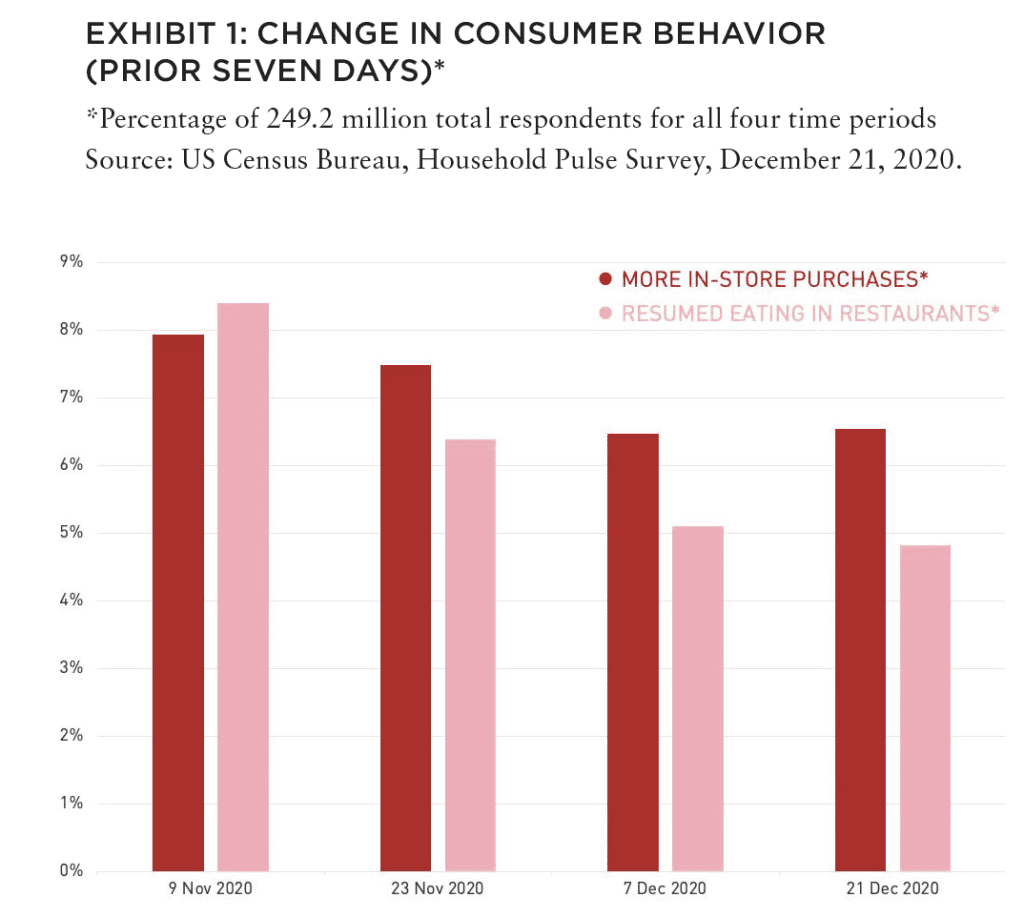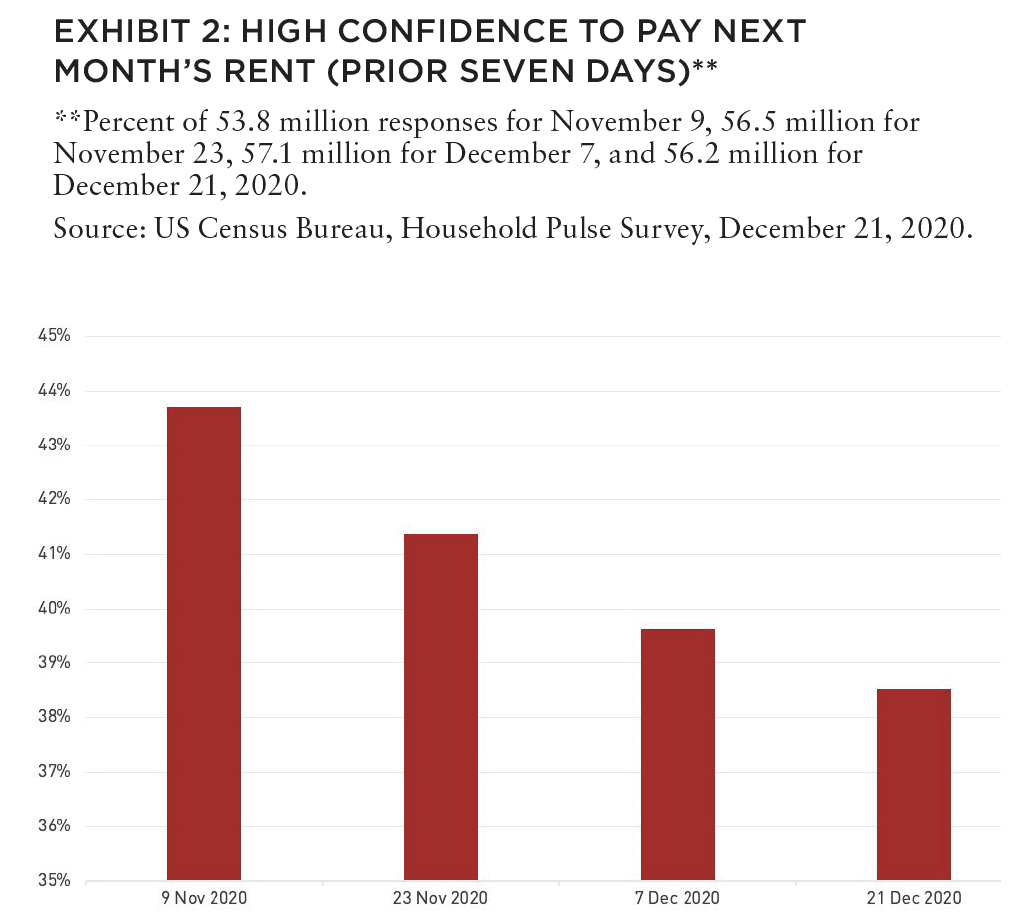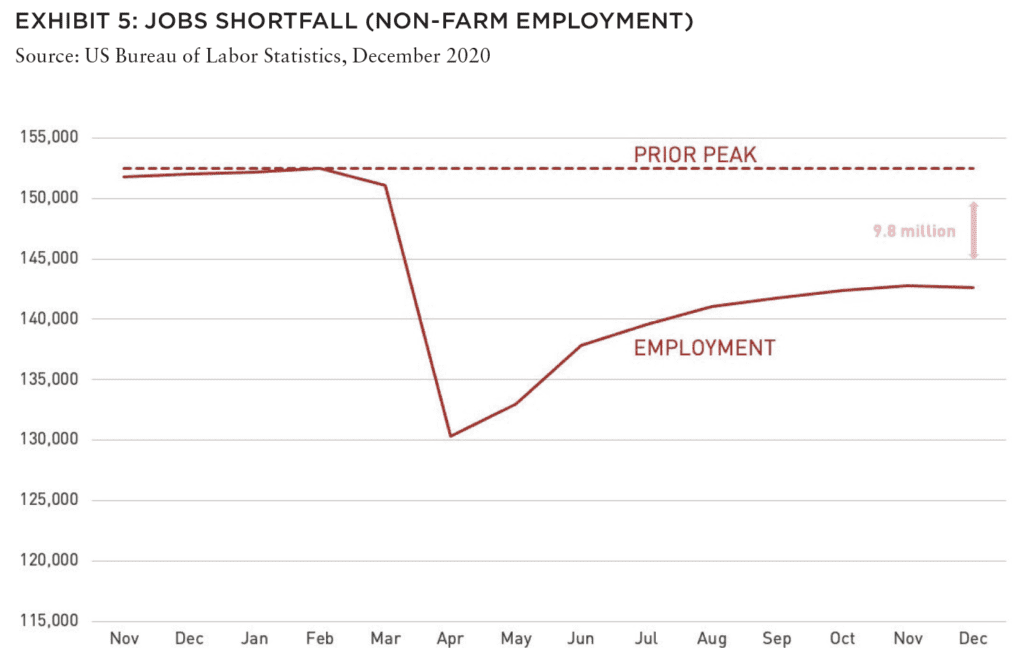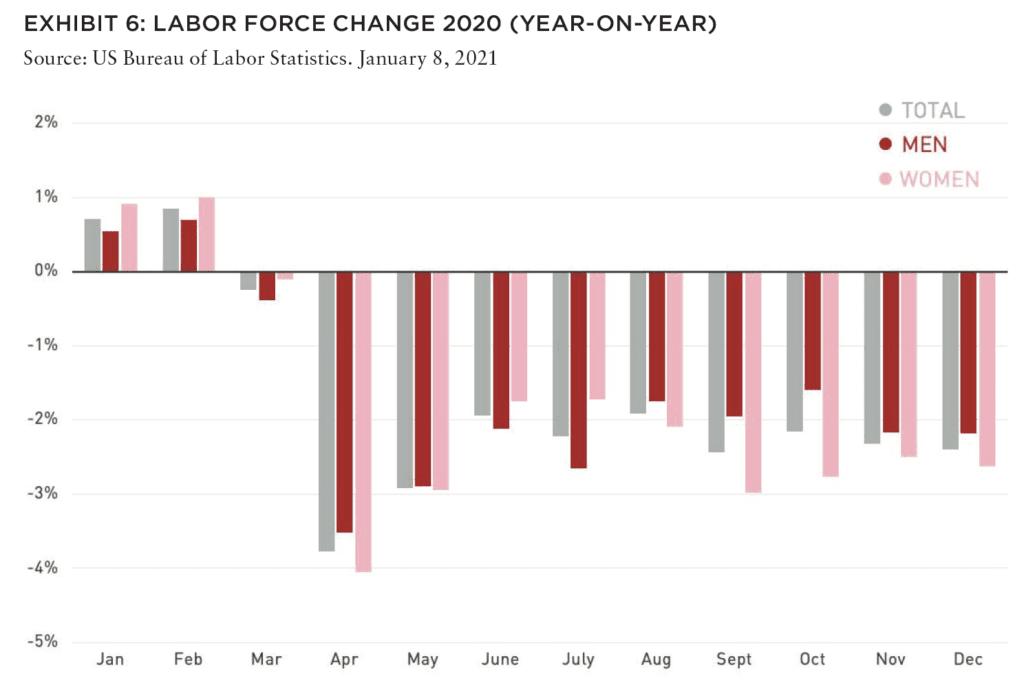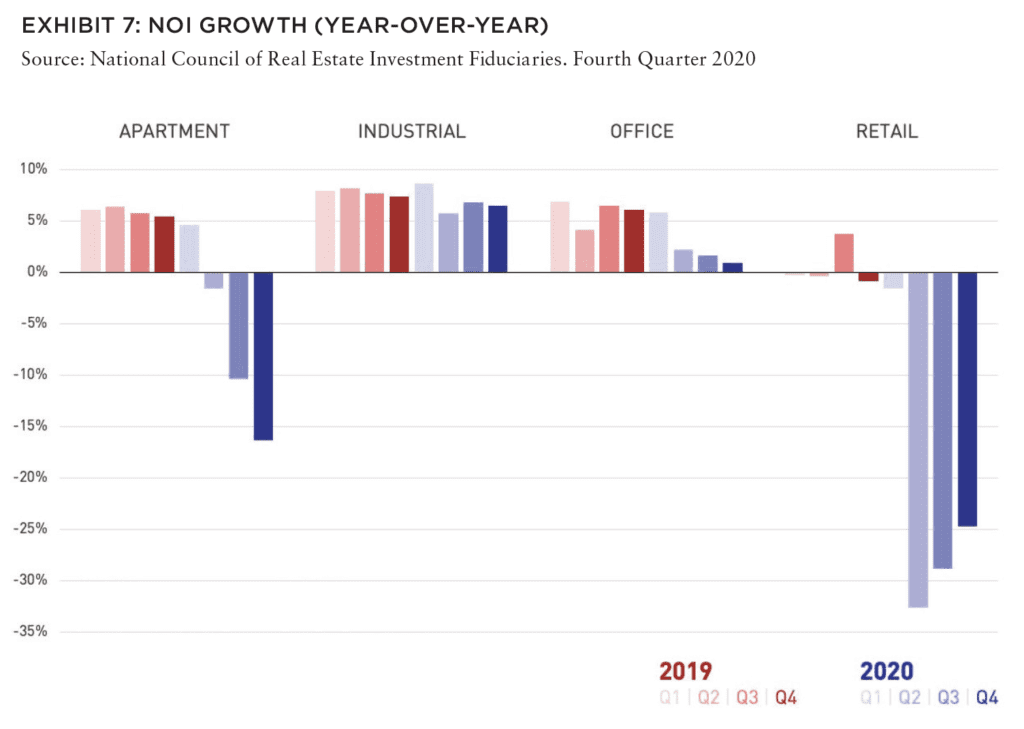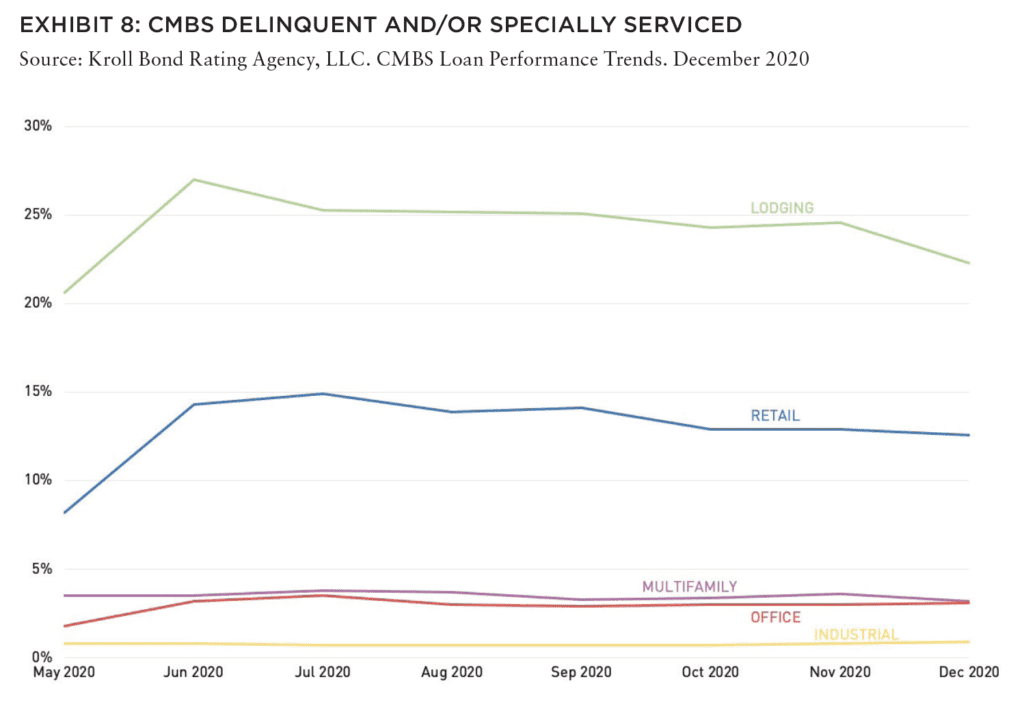How is commercial real estate set to perform in the post-COVID world?
As COVID-19 vaccine distribution commences, it is time to turn attention to prospects for commercial real estate (CRE) performance in the post-COVID world.
We are still experiencing the slow emergence of the long-term knock-on effects of the pandemic on CRE performance. While many hypothetical effects of the virus on commercial property have been discussed, there is enormous uncertainty regarding the durability of such effects and their consequence for investors. Analysts have many metrics that can offer insight, but they are so numerous as to constitute yet another source of confusion. This article offers a small subset of available indicators that we are monitoring as leading indicators of the long-term effects on the industry.
CONSUMERS EAGER OR RELUCTANT TO RESUME NORMAL ACTIVITIES?
The retail and hotel property sectors are bearing the brunt of the COVID disruption. Weaker businesses are shuttering, vacancy rates are surging, rent collections are shrinking, property values are dropping, and commercial mortgage delinquencies are rising. Investors in these sectors are struggling to find a path forward. To understand the full potential of the impact the pandemic will have on CRE, we must consider the effect it has had on consumers.
The US Census Bureau started tracking consumer reactions to the pandemic by creating a new Household Pulse Survey in April 2020.
The survey produces a wealth of data that tracks the prospects for a resumption in pre-COVID consumer behavior. Consider three telling indicators tracked by the survey (Exhibit 1):
- Percent of households making more in-store purchases over the prior seven days
- Percent resuming restaurant dining over prior seven days
- Percent of renter households with high confidence of making their next month’s rent payment (Exhibit 2)
Recent survey results demonstrate the negative impact of the surge in COVID-19 cases during November 2020. Households reported fewer in-store purchases, weaker resumption of restaurant dining, and less confidence in making rent payments. These results translate into ongoing stress on the retail sector and increasing stress on the apartment sector. The new US federal support package should provide some relief in 2021 for rent payments, but improvement for in-store shopping and restaurant dining will require success in distributing the vaccine and restoring consumer confidence.
All this provides both an imperative and an opportunity for the real estate industry— supported by policymakers— to reimagine our built environment and reset current policy and practice toward that vision. To this end, these leaders must recognize the need to create more “communities of opportunity”—with full appreciation of the fiscal, social, and environmental benefits that doing so will yield for cities and regions. More than that, they need to embrace their role and responsibility in shaping that future.
WHAT ARE “COMMUNITIES OF OPPORTUNITY”?
Another area of concern for CRE investors is the decreasing allure of dense urban areas as the pandemic has encouraged working from home. This, in turn, set off a variety of knock-on effects including appetite for more living space at a lower cost than in downtown locations. Leasing of suburban apartments and single-family home sales have both been booming while downtown apartment vacancies have been rising. But, at the same time, downtown apartment rents have been dropping in response, especially in the most expensive cities, including New York and San Francisco (Exhibit 3).
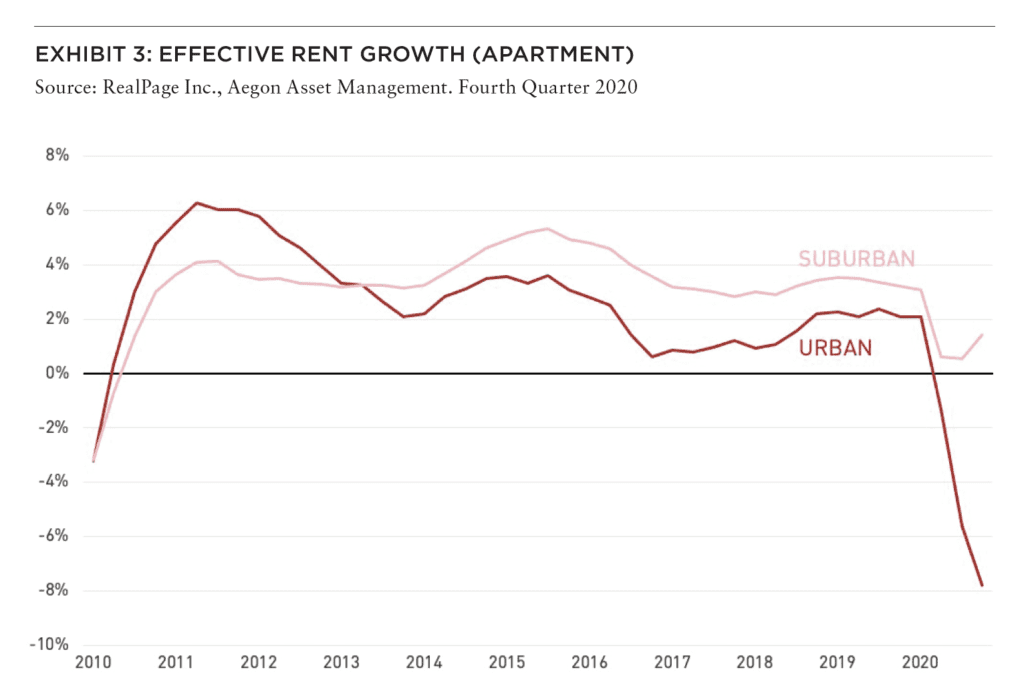
ALSO IN SUMMIT (SPRING 2021)
GREAT LAKES / Tightening the Belts: How are shorthand labels like the “Sun Belt” and the “Rust Belt” shaping investment decisions? Should they?
AFIRE | Gunnar Branson and Benjamin van Loon
SOCIAL ISSUES / The Great Real Estate Reset: A data-driven initiative to remake how and what we build.
Brookings | Christopher Coes, Jennifer S. Vey, and Tracy Hadden Loh
SOCIAL ISSUES / Confronting the Myth: The events of the past year have driven businesses to confront racial inequity, but some still shy away from the challenges needed to make real progress.
Alfred Dewitt Ard Consulting | Shumeca Pickett
INDUSTRY OUTLOOK / CRE Prospects Post-COVID-19: How is commercial real estate set to perform in the post-COVID world?
Aegon Asset Management | Martha Peyton
HOSPITALITY / Time to Check In: If history is a guide, the time to invest in hotels is when things look bleak. This appears to be one of those times.
Barings Real Estate | Jim O’Shaughnessy
HOSPITALITY / Hoteling 2.0: The pandemic has impacted the hospitality, but a growing wave of non-traditional investors has shown heightened interest in the evolving industry.
JLL Hotels & Hospitality Group | Gilda Perez-Alvarado
RESIDENTIAL / Safe as Houses?: The future of residential investments is all about demographics—and the forces behind them.
American Realty Advisors | Sabrina Unger
RESIDENTIAL / Housing for Goldilocks : The pandemic highlights the advantages of single-family and appears to have accelerated migration to less dense, more affordable areas.
GTIS | Eliot Heher and Robert Sun
DATA CENTERS / Data Centers, Stage Center: Data center investments have proven resilient in periods of volatility—and they’re only going to become more essential and important into the future.
Principal Real Estate Investors | Bob Wobschall
CLIMATE CHANGE (WHITE PAPER) / Rather Than the Flood: A comprehensive look at climate-induced water disasters and their potential impact on CRE in the US.
New York Life Real Estate Investors | Stewart Rubin and Dakota Firenze
LOGISTICS / Reforging the Supply Chain: The only way to deliver on the service promises of a booming logistics sector requires a complete reimagination of the supply chain.
Stockbridge | David Egan
DEBT AND LEVERAGE / Leveraging Control: Though leverage is an important part of capital funding, it’s important to ask LPs if (and how) they should take control of their real estate leverage.
RCLCO Fund Advisors | William Maher and Ben Maslan
DEVELOPMENT / Recasting Risk and Return: The investment community can have an active role in economic recovery—but it will require recasting the traditional risk/return framework.
Standard REI | Shubrhra Jha
CORPORATE TRANSPARENCY ACT / Transparency Rules: Non-US-based investors face the disclosure regime of the Corporate Transparency Act. What do you need to know?
Pillsbury | Andrew Weiner
PENSIONS (WHITE PAPER) / Rising Pressures: The latest joint, in-depth report from Praedium and SitusAMC looks at rising fiscal pressures on state and local governments.
Praedium Group and SitusAMC Insights | Russell Appel, Peter Muoio, and Cory Loviglio | SitusAMC Insights
TALENT AND HR / Plugging the Skills Gap: Several trends are forcing change in the global commercial real estate industry, driving demand for new skills. How is the industry responding?
Sheffield Haworth | Max Shepherd
ESG / Operationalizing the Sustainability Agenda: During a time of unprecedented disruption, how should businesses approach the “new metrics” ESG of performance?
AccountAbility | Sunil A. Misser
Will the trend away from dense urban living be long term? Occupancy data (Exhibit 4) can answer that question, as the data respond to changes in relative rents and home prices, work-from-home prevalence as the pandemic ends, confidence in the safety of public transportation for commuting, long-term location choices of employers, and appetite of residents to live in the midst of city excitement. We see the data supporting the causal observation that suburban areas are benefitting. The longer-term question for investors is whether the decline in the attractiveness of urban areas is durable or fleeting? Tenants continually digest the costs and benefits of their domiciles.
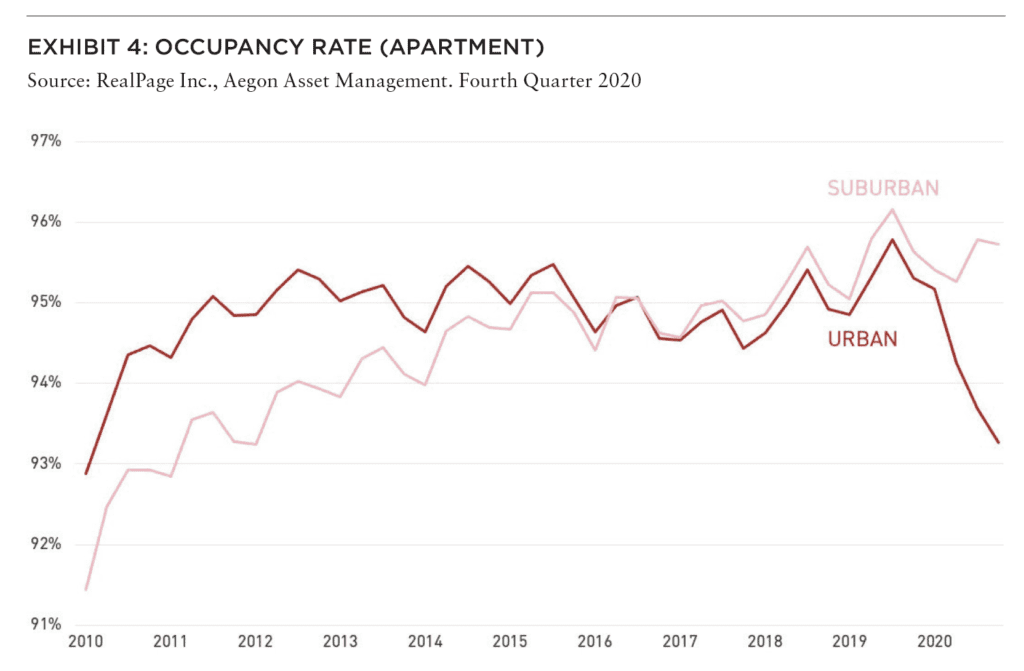
LABOR FORCE SHRINKAGE PERSISTING AND IMPAIRING GROWTH PROSPECTS?
We believe that monitoring monthly changes in the unemployment rate is proving to be inadequate for assessing the impact of COVID-19 and will continue to be inadequate for discerning what is to come. The unemployment rate is calculated as a percentage of the labor force, which is defined as those willing, able, and actively looking for work. It was widely applauded when the unemployment rate in 2020 declined steadily from 14.8% in April to reach 6.7% in December.1 That improvement disguises the absolute 9.8 million shrinkage in employment in 2020 from February through November (Exhibit 5). [1]
As shown in Exhibit 6, in 2020 the labor force was smaller every month between March and December compared to the same months in 2019. The shrinkage amounted to roughly 4.2 million individuals in December 2020, split about equally between men and women (Exhibit 6).[1]
Labor force shrinkage can occur when individuals become discouraged and cease looking for work. In December, the unemployment rate was 7.1%, including such discouraged workers, compared with 6.7% excluding them.[1] As economic recovery takes hold and jobs become more available, it is likely that discouraged workers will return to the workforce. But concerns about health safety on public transportation might be a deterrent and require reassurance from public authorities.
A more problematic category includes those who left the labor force during the pandemic to look after children or elders. In December 2020, this category totaled 1.5 million individuals, with women comprising more than half of that number.[1] Returning to the labor force for this group will require that childcare and school return to pre-pandemic “normal;” that children return to those venues with minimal distress, and that parents rebuild confidence in the safety of those facilities. Similar recovery in eldercare availability and confidence is necessary as well. At the same time, it bears mentioning that US labor force growth was weak even before the pandemic. Restoring the labor force to pre-pandemic levels will not be enough to boost long-term economic growth beyond the recent 2% average (+/-). At the same time, if the labor force does not recover and grow, even a tepid pace of US growth will be hard to achieve. Such an outcome would diminish demand for all CRE and discourage rent growth in the years ahead.
LAGGED FINANCIAL DISTRESS EMERGING IN CRE?
CRE demand and supply are driven by macroeconomic and capital markets forces. Their operation is demonstrated in the flow of property leasing, rents collected by owners, and new construction. Leases can be as short as one-night hotel rooms or as long as typical ten-year leases on office and retail space. The translation of macroeconomic and capital markets forces into CRE performance takes time. This is demonstrated in the quick plunge in hotel occupancy rates, as the pandemic took hold, versus the much smaller increase in office vacancy rates despite the shift to work-from-home.
We believe the impact of COVID-19 on CRE will become evident as space demand recalibrates, ultimately affecting the net operating income (NOI) collected by owners. Recalibrated NOI flows, in turn, will affect the performance of commercial mortgage credit. As shown in Exhibit 7, NOI contraction began for retail properties in Q1 2020 just as the pandemic took hold and retail, along with hotels, has suffered a sharp rise in commercial mortgage distress. By the third quarter, some erosion in apartment NOI appeared as well, perhaps reflecting the expiration in enhanced unemployment compensation. Through 2021, it is likely that these stresses will become more serious as lagged effects play out. However, a faster and stronger economic rebound, supported by vaccines distribution, could mitigate the damage.
At the same time, NOI data will also show structural changes underway in each sector. In particular, office space might suffer prolonged distress as work-from-home and space-per-employee needs are clarified. Retail and industrial sector results will similarly adjust to show how much viability returns to bricks-and-mortar shopping. These metrics will help investors to focus on stronger opportunity and avoid laggards.
LOOKING FORWARD
While the current environment is more hopeful with the implementation of effective COVID-19 vaccines, uncertainty remains enormous. We have identified and are monitoring a small number of metrics that can serve as leading indicators of the potential long-term effects of COVID-19 on commercial property:
- Consumers eager or reluctant to resume normal activities
- Location preferences shifting away or returning to urban vs suburban localities
- Labor force shrinkage persisting and impairing growth prospects or recovering
- Lagged financial distress emerging or resolving in CRE
Strong data backing these four indicators will guide us to more educated insights into the ramifications of this pandemic and allow us to potentially position ourselves to take advantage of market dislocations.
—
ABOUT THE AUTHOR
Martha Peyon, PhD, is Managing Director of Applied Research for Aegon Asset Management, the global investment brand of Aegon N.V.; is a US-based investment adviser registered with the Securities and Exchange Commission (SEC); and part of Aegon Asset Management, the global investment management brand of Aegon Group.
NOTES
1. “The Employment Situation,” US Bureau of Labor Statistics, 10 January 2020, bls.gov/news.release/archives/empsit_01102020.htm



